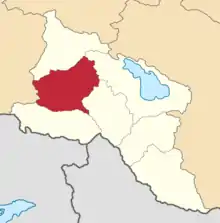Etchmiadzin Uyezd
The Etchmiadzin Uyezd (Russian: Эчмиадзинский уезд; Armenian: Էջմիածնի գավառ) was an uezd (county) of the Erivan Governorate of the Caucasus Viceroyalty of the Russian Empire. The uezd bordered the Alexandropol Uezd to the north, the Nor Bayazet Uyezd to the east, Erivan Uyezd to the north, the Surmalu Uyezd to the south, and the Kars Oblast to the west. It included all of the Armavir Province and most of the Aragatsotn Province of present-day Armenia. Its administrative center was the town of Etchmiadzin (Vagharshapat), the center of the Armenian Apostolic Church and the spiritual capital of all Armenians.[1]
Etchmiadzin Uyezd
Эчмиадзинский уезд | |
|---|---|
.png.webp) Coat of arms | |
 Location in the Erivan Governorate | |
| Country | Russian Empire |
| Governorate | Erivan |
| Viceroyalty | Caucasus |
| Established | 1849 |
| Abolished | 1930 |
| Seat | Etchmaidzin (Vagharshapat) |
| Uchastoks | First, second, and third |
| Area | |
| • Total | 3,858 km2 (1,490 sq mi) |
| Population (1916) | |
| • Total | 167,786 |
| • Density | 43/km2 (110/sq mi) |
Administrative divisions
The Etchmiadzin Uyezd was split into 3 unnamed contiguous uchastoks (subcounties):
- 1st (1-ий участок)
- 2nd (2-ий участок)
- 3rd (3-ий участок)
Demographics
Russian Imperial Census of 1897
According to the Russian Empire census of 1897, the Etchmiadzin Uyezd had a population of 124,237, including 65,072 men and 59,165 women. The majority of the population indicated Armenian to be their mother tongue, with significant Tatar (later known as Azerbaijani) and Kurdish speaking minorities.[2]
| Language | Native speakers | % |
|---|---|---|
| Armenian | 77,572 | 62.44 |
| Tatar[lower-alpha 1] | 35,999 | 28.98 |
| Kurdish | 9,724 | 7.83 |
| Tat | 439 | 0.35 |
| Assyrian | 198 | 0.16 |
| Russian | 94 | 0.08 |
| Ukrainian | 81 | 0.07 |
| Georgian | 51 | 0.04 |
| Jewish | 27 | 0.02 |
| Turkish | 9 | 0.01 |
| Polish | 8 | 0.01 |
| Persian | 8 | 0.01 |
| Greek | 5 | 0.00 |
| German | 2 | 0.00 |
| Other | 20 | 0.02 |
| TOTAL | 124,237 | 100.00 |
Caucasian Calendar of 1917
The 1917 Caucasian Calendar which produced statistics of 1916 indicates 167,786 residents in the Etchmiadzin Uyezd, including 86,716 men and 81,070 women, 148,794 of whom were the permanent population, and 18,992 were temporary residents. The statistics indicated an overwhelmingly ethnic Armenian population with sizeable Azerbaijani, Kurdish and Yezidi minorities:[3]
| Nationality | Etchmiadzin | |
|---|---|---|
| Armenians | 115,026 | 68.6% |
| Azerbaijanis | 41,310 | 24.6% |
| Kurds | 9,653 | 5.8% |
| Yezidis | 1,118 | 0.7% |
| Gypsies | 410 | 0.2% |
| Assyrians | 186 | 0.1% |
| TOTAL | 167,786 | 100.0% |
Notes
- Later known as Azerbaijani.
References
- Tsutsiev, Arthur (2014). Atlas of the Ethno-Political History of the Caucasus. Translated by Nora Seligman Favorov. New Haven: Yale University Press. p. 59. ISBN 9780300153088.
- "Демоскоп Weekly - Приложение. Справочник статистических показателей". www.demoscope.ru. Retrieved 2022-03-26.
- Кавказский календарь .... на 1917 год (in Russian). pp. 367–370.